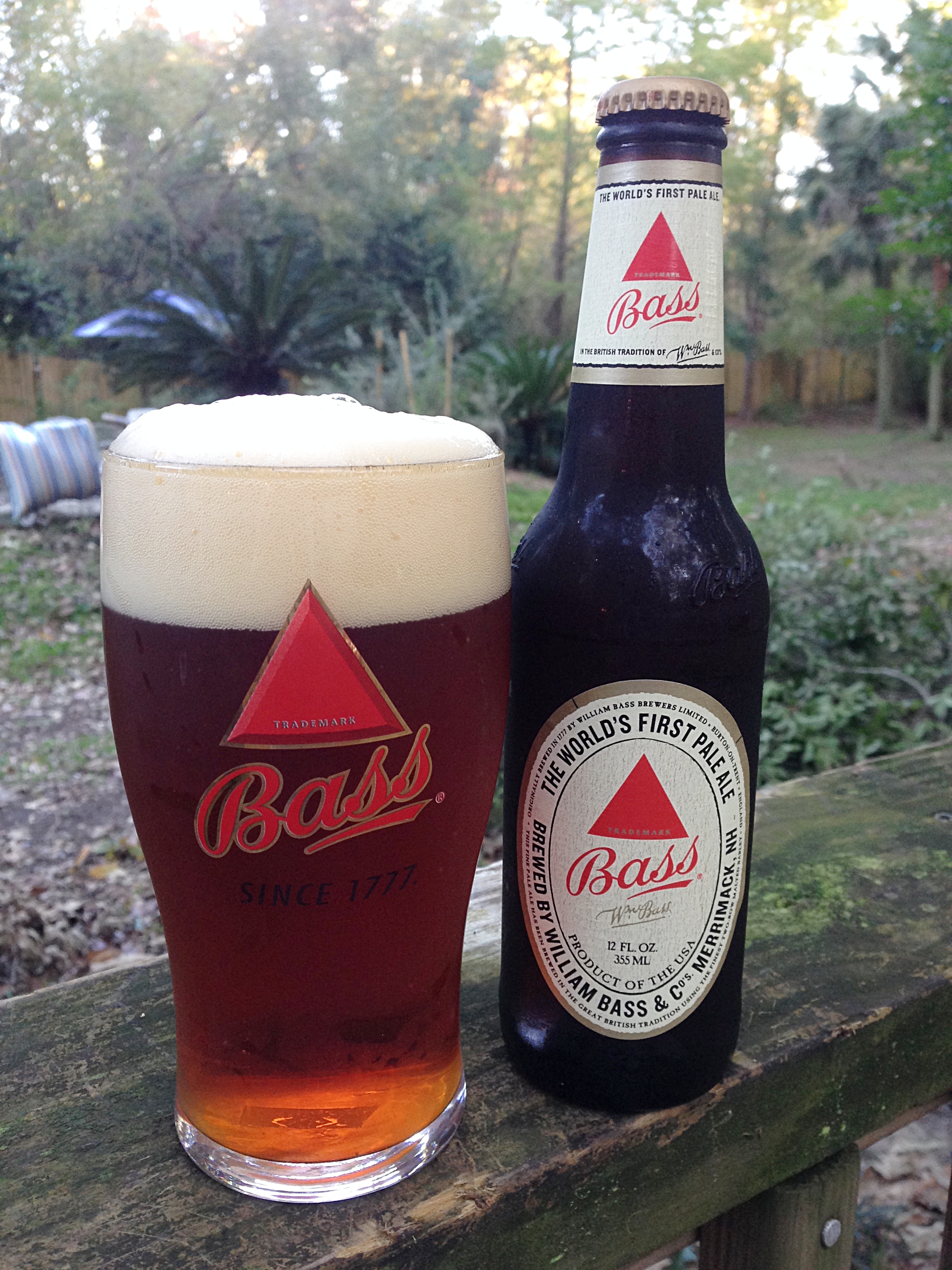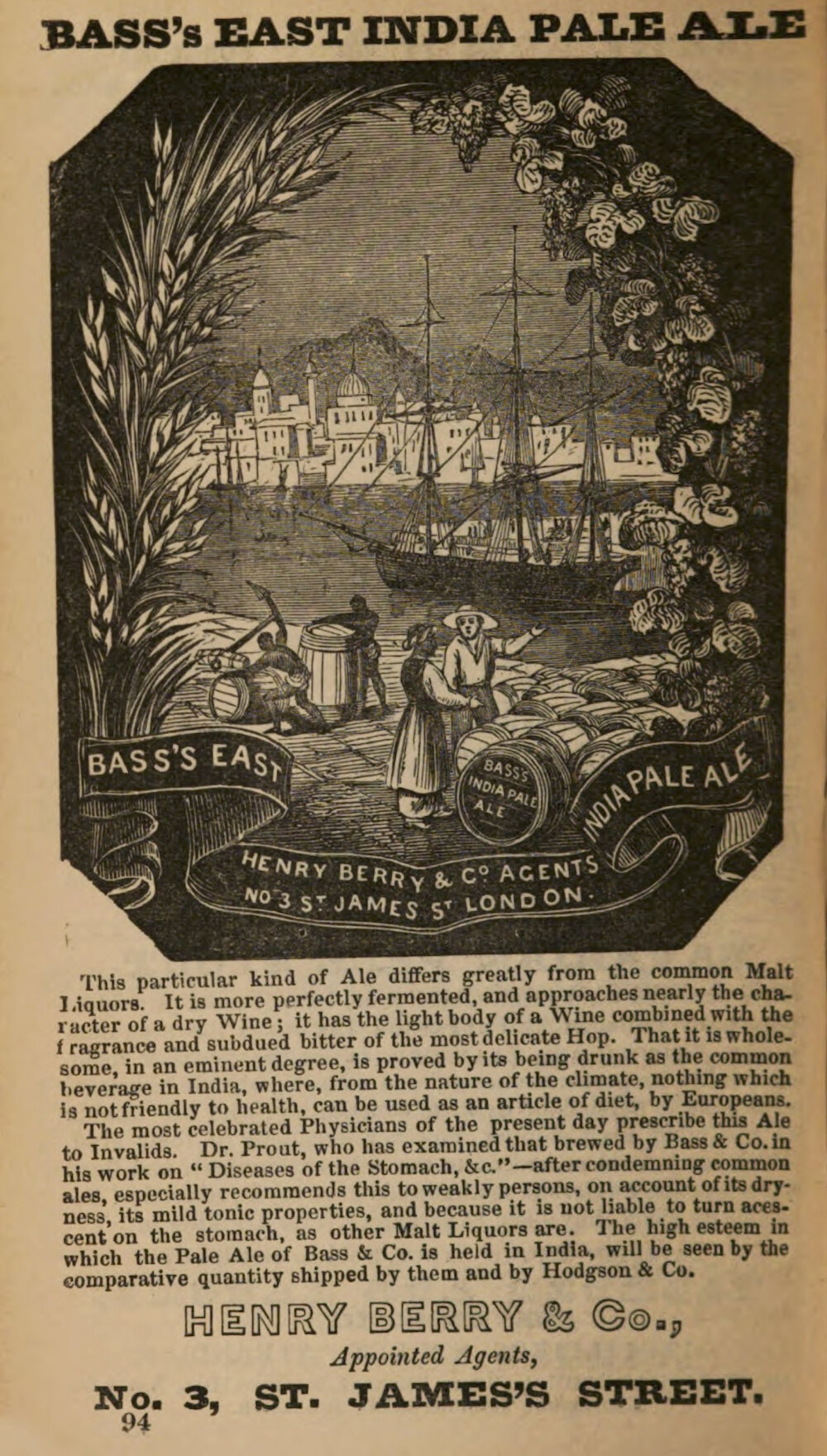William Bass & Company :
Bass Pale Ale
Bass Pale Ale - for years my go-to pale ale. Now made in the USA.
Bass Pale Ale - what can I say - it's made in New Hampshire. It says so right on the label, so I guess they (they being AB InBev, of course) are not trying to pull a fast one on the North American consumer by hiding this fact. Well, at least Hampshire sounds sort of British.
Today, it is really rather difficult to determine the exact provenance of Bass Ale, as it all depends on where you are drinking it, draft or bottled, and what stage of the international mega-merger and/or licensing agreement process the parent company is involved in at the time. Suffice it to say, the Bass Ale you buy at your package store here in the U.S. is made in New Hampshire. They claim that Bass Ale is still brewed to the original recipe developed by William Bass back in 1717, in his brewery in Burton-upon-Trent. Maybe so but, knowing how important water content and quality is to the taste of beer, I would be surprised to find they tanker the water, ancient water taken from local wells, across the Atlantic.
(As a kid growing up in Omaha, Nebraska, we used to joke that the water used to brew Falstaff was pure un-filtered Missouri river water.)
The iconic red triangle was the first trademark issued in England - back in 1876. Not quite so well known was the red diamond assigned to Bass Strong Ale.
Image courtesy of AB InBev
While many may find this a bit disconcerting, and are put off by it all, personally I try not to dwell on it too much, as I think Bass Ale is still a good beer. Perhaps it is not my go-to British pale ale like it had been for years, but I still enjoy a pint or two, every now and then. So if someone offers you a Bass Ale, try not to think about it too hard, and just enjoy a fine tasting beer.
A little story: One hot, sultry, humid day a few summers ago, I had just finished up some sweaty noxious chore in the yard, and was sitting down to a few celebratory beers, celebrating having just finished mowing, or raking, or something, without suffering from heat stress. So I went to my garage pub and pulled out a nice cold bottle of Red Stripe. You know Red Stripe - it's that Jamaican lager in those fat little bottles. Now, I have done a bit of running around in Jamaica in my day, and enjoying Red Stripe quite close to its source. I was always partial to it as a refreshing beer on a hot summer day, and these days it reminds me of being on the island even though I haven't been back to Jamaica for a few years now. Anyway, I'm sitting in the driveway, drinking a Red Stripe, when I began to read the label on the bottle. "Brewed and Bottled in Latrobe, Pennsylvania." Say what?
Well, a bit of research later I found out that, like Bass Ale, Red Stripe was subject to a convoluted and confusing series of buy outs, contracts, international marketing agreements, brewing deals, etc... Turns out, since 2012, the Red Stripe I was drinking was brewed at the old Rolling Rock brewery. I was rather disappointed to find out that the Red Stripe I was drinking in the U.S. was not Jamaican, similar to the way I felt about Bass Ale not being made back in the home sod.
But I got over it, and still drink a fair share of both Red Stripe and Bass Ale. They are still good beers.
For an interesting history of Mr. William Bass, and his ale, published circa 1884, please click here. It's a pretty big pdf, so give it a minute to load - it's a good read.
Edouard Monet's 1882 painting - A Bar at the Folies Bergere. Can you find the Bass Pale Ale?
Michael Thomas Bass (1799-1884) was the grandson of William Bass. Michael Thomas Bass took over the Bass brewing concern from his father - who was also named Michael Thomas - in 1827, and was credited in growing the brewery into the largest brewery in the world. In addition to being an astute businessman, he was himself a master brewer, and later in life a Member of Parliament. This image is from the book “Beer, It’s History and Economic Value as a National Beverage,” by F.W. Salem, published in 1880.
A little poem about the virtues of Burton Ales, from the book “Curiosities of Beer & Ale - An Entertaining History” by John Bickerdyke. London 1889
World's Production of Beer, 1913
From the 1915 edition of the Brewers' Almanack. Rather interesting is the number of breweries in France.
And, The Award Goes To … Bass Ale. Hurray!
Even south of the Channel, Bass Ale was making a hit, and scoring a few medals - good for Bass Ale. Article from the 30 September 1890 issue of “The Brewers Guardian.” Well done Bass Ale - Cheers!
This is an advert from the 1844 edition of the “Royal Blue Book.” This book lists all the British royalty and staff, right from the top down to the royal dog catcher.
Is This The Real Bass Pale Ale?
From the book “Boston Of To-Day, A Glance At Its History and Characteristics,” published by the Post Publishing Company, Boston, 1892.
It appears that Bass Pale Ale had a bit of a following in the U.S., even back in the 1800s. Well maybe. I am not all too sure that this is truly Bass Pale Ale. Chester H. Graves & Sons was a Boston company that was alternatively referred to as an alcoholic beverage merchant, a manufacturer of spiritous liquors, a distiller, and/or as a rectifier. It seems to have been around from around 1850 to at least the turn of the century. The blue label below is from an 1891 trademark application. This is the only mention I have found that connects Bass Pale Ale with the Graves company. Could it be that Graves was bootlegging (no pun intended) the good name of Bass Pale Ale? Perhaps. Drop us a line if you know more.
Cheers,
Dave
This was from an 1891 Trademark application filed by the Graves & Sons Company, Boston.
An advertisement from the 1881 issue of “The Boston Directory.” You have to wonder what exactly was in Hub Punch. It may be rather good, or it may be really bad.
A page from the booklet “Simple Facts About Wines, Spirits, Ale and Stout” published by Alex D Shaw & Co. - Wine Merchants Since 1881. New York City - 1934.
From the U.S. Patent and Trademark Office - 1882
Lots of ales and stouts here. Numbers 1, 2, and 3 Strong Ales - what would these be?













